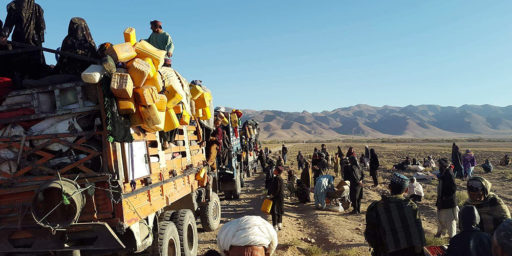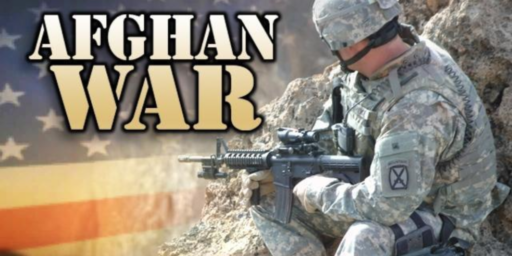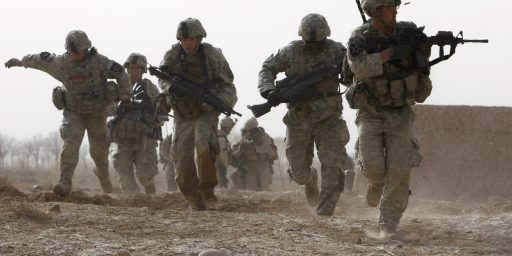President Obama Announces Yet Another Slowdown Of Withdrawal From Afghanistan
American forces will continue to stay in Afghanistan well after Barack Obama leaves office thanks to a new policy announced today.
Continuing a pattern that has been going on for years now, President Obama announced this morning that the drawdown of American forces in Afghanistan, which has already been changed from the original plan several times over the course of the past three years, would be slowed even further:
WASHINGTON — President Obama said on Wednesday that he would leave 8,400 American troops in Afghanistan until the end of his term, further slowing the drawdown in a 14-year war that Mr. Obama had pledged to end but now seems likely to grind on indefinitely.
Acknowledging that security in Afghanistan remained tenuous, Mr. Obama said he was adjusting, yet again, a plan to gradually draw down American forces by the end of his term. His announcement leaves his successor with a substantial military commitment in the country, though far less than the close to 40,000 troops who were fighting there when Mr. Obama took office.
“The security situation remains precarious,” Mr. Obama said in a brief statement at the White House. “Even as they improve, Afghan security forces are still not as strong as they need to be. The Taliban remains a threat. They’ve gained ground in some cases.”
The United States currently has slightly fewer than 10,000 troops in Afghanistan who train and equip Afghan forces and carry out counterterrorism operations. Mr. Obama had left open the option of reducing that number to 5,500 by the end of 2016 or early 2017.
Now, more than 8,000 troops will remain, and it will be up to Mr. Obama’s successor to decide on any further reductions. Mr. Obama recently loosened the rules of engagement for American troops to give them the ability to fight the Taliban directly and more flexibility to carry out airstrikes and wage ground combat in support of Afghan forces.
Mr. Obama cast his decision as a vote of confidence in Afghanistan’s unity government and NATO members and other partners, who have contributed 6,000 additional troops to Afghanistan. But it also reflects that the American hopes of building a viable Afghan force, capable of securing the country, have fallen far short.
“We’ve been able to end our ground war,” Mr. Obama said. But he added, “We have to deal with the realities of the world as they exist.”
Mr. Obama said he had made the decision after a lengthy internal debate, and based on a recommendation from the new American commander in Afghanistan, Gen. John W. Nicholson. The Pentagon had argued that the larger number of troops was necessary to provide Afghan forces with enough support to fend off the Taliban.
The decision also reflected worries in the administration that Al Qaeda was regrouping in Afghanistan, and that the Islamic State had established a foothold there. Mr. Obama repeated his vow that he would not allow Afghanistan to be used as a safe haven for terrorists.
More from The Washington Post:
President Obama announced revised troop plans for Afghanistan on Wednesday, keeping 8,400 U.S. troops in the country when he steps down early next year, the clearest indication yet of his inability to end the long war there.
“I strongly believe that it is in our national security interest, especially after all the blood and treasure we’ve invested in Afghanistan over the years, that we give our Afghan partners the very best opportunity to succeed,” said Obama, speaking at the White House. He had hoped to leave a force of 5,500 in early 2017.
Obama, who came into office promising to end the wars started by his predecessor, has already changed his timetable for removing troops from Afghanistan several times as local forces struggle to contain a resilient Taliban insurgency.
There are now about 9,800 U.S. troops in Afghanistan, tasked with a dual mission to support local forces and hunt down al-Qaeda and other militants. That’s much smaller than the force of about 100,000 stationed in Afghanistan during Obama’s 2010-2011 troop surge.
Speaking alongside Defense Secretary Ashton B. Carter and Gen. Joseph Dunford, chairman of the Joint Chiefs of Staff, Obama said the United States was no longer fighting a “major ground war” in Afghanistan.
But he acknowledged it would take more time for the Afghan security forces to build up the military capacity they need to combat not just the Taliban but a host of militant groups including the Islamic State.
He said only a peace deal would bring lasting stability to Afghanistan.
As part of current military plans, the United States will also maintain a series of bases across Afghanistan that will afford U.S. and NATO troops greater reach into contested areas.
Already over the last two years, Obama had given commanders in Afghanistan new powers to combat militants, an acknowledgment that the official end to U.S. combat operations at the end of 2014 did not signal a halt to the fighting.
This announcement is the second time this year that President Obama has announced a shift in U.S. policy in Afghanistan from the previously stated position that had placed the nation on track to have most, if not all troops out of the country by the end of 2016, or at least the end of President Obama’s time in office less than a month later. Five months ago, Obama announced that American troops would be deployed back into areas of Afghanistan where active combat was occurring, a reversal of the policy that was largely restricting them to garrison bases and leaving much of the combat against the Taliban to the Afghan Army. Prior to that, in October 2015, President Obama announced that the withdrawal of U.S. forces would be halted due to the ongoing threat posed by a resurgent Taliban in several Afghan provinces. A year before that, not long after the President had announced the new plan that was supposed to ultimately lead to the final withdrawal of American forces, it was announced that that plan would be changed and that American forces would continue to be involved in combat operations. Several months after that, after the then-new Afghan President Asraf Ghani visited the United States it was announced that the pace of withdrawal would be slowed even further. Finally, in April 2015 we learned that American forces were involved in more than just the counterterrorism operations that President Obama’s original plan had said they would be limited to. In other words, the history of the past two or three years vis a vis Afghanistan has been one in which the President’s initial policy of finally ending the American commitment to Afghanistan was pushed further and further back.
All of this sounds all to close to what I wrote back in March:
At this rate, it seem inevitable that we’ll reach a point some time this year when the President will announce, no doubt with frequent use of the word “regretfully” or some similar word, that the previous commitment to remove most American troops by December 31st cannot be met. That announcement will likely come either early in the year or after the election so as to minimize the political impact, but it is the inevitable next step in all of the delays to withdrawal that the Administration has announced over the past fourteen months. More likely than not, the President will simply punt the matter into the future, perhaps by delaying the “official” withdrawal date for six months or so, thus leaving the matter for the next President to decide. All of this will occur contemporaneously with likely future increases in American commitments in Iraq and Syria related to the fight against ISIS, thus leaving quite a lot on the plate for the next President that could very well significantly distract them from being about to carry out any domestic agenda.
The practical impact of all this, of course, is that America’s longest war is likely to continue even longer, and that there will be a significant American military presence in the country for some time to come. When the next President, most likely Hillary Clinton, takes office, it’s likely that they will order a ‘security review’ of the situation in the country just as President Obama did when he took office. While that is pending, it’s unlikely that any further drawdown will take place until the review is complete. Additionally, given the manner in which policy has proceeded over the past three years, it seems apparent that the relevant military commanders are more likely to recommend keeping current force levels in place than they are to recommend withdrawal, a recommendation that most likely will be followed. Meanwhile, the situation in Afghanistan is likely to remain the same, and the likelihood that American forces could be subject to terrorist attacks for no good reason will just increase.





The number of American soldiers remaining in Afghanistan is only half the story. The other part, as you began to address later in the post, is the large, poorly-defined, maybe impossible mission they’ve been assigned.
The mission is to keep the Kabul government alive and the Taliban from seizing power. That’s not very confusing at the top level. It may lead to confusing situations on the ground, but in general that’s it and it’s pretty easy to understand.
Had we found an excuse to place troops in Afghanistan prior to 2001 I doubt we’d have seen 911 and all the sequelae. American garrisons have brought peace to Europe and Japan and a sort of peace to South Korea. I don’t know whether this is the magic minimum number or not, but I’m not terribly upset at 8000 guys in Afghanistan.
Incidentally, we have an equal number in the UK, substantially more (11,000) in Italy, 37,000 in Germany, 25,000 in South Korea, 52,000 in Japan. This would be I believe our 6th largest overseas deployment.
@michael reynolds:
And if we’d stationed troops in Germany after World War I, Hitler might not have come to power and there might have been no World War II. And if we’d opposed them when the Japanese invaded China there might have been no World War II in the Pacific and no Long March.
We can fantasize like this all day but the reality is that we can’t even support the force we have in Afghanistan without the cooperation of the Pakistani government and there is no evidence they would have allowed us to fight an aggressive war against the Taliban no matter how much we paid them prior to 9/11.
Meanwhile NATO fears Russian attack as things are heating up in that area. Borders are tightened.
Compared to the continued threat from international terrorism as well as continued problems such as the Taliban infiltrating training Afghan units as well as training and discipline problems that persist among many Afghan soldiers, this is probably an inadequate number of American troops and military advisors. American public opinion may encourage the White House to withdrawal troops, but in the face of the continued difficulties as well as threats present in Afghanistan, this is not a realistic foreign policy approach. Public opinion cannot drive policy to defeat the continued threat from international terrorism. This policy needs to be in hands of expert opinion, not public opinion.